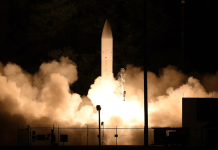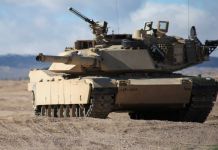Iran sets sights on Israel’s enigmatic Dimona nuclear facility. Curiously, this very facility eluded US intelligence for quite some time after breaking ground in 1958. It took the keen eye of a University of Michigan professor in December 1960 to finally unmask its existence.
Iran’s Missile Strike
On October 1, Iran launched approximately 200 ballistic missiles at Israel, escalating an already volatile situation in the Middle East. The attack came days after Israel killed the leader of the Iran-backed Hezbollah and deployed troops into Lebanon.
Among the targets of Iran’s missile barrage was the Israeli nuclear facility at Dimona—a location long coveted by Iranian military planners.
The Dimona nuclear facility has long been the prime target of Iran’s ambitions for long-range strikes.
Several videos surfaced, showing rockets landing in desert areas, likely aimed at Dimona, although they failed to cause substantial damage.
In the early hours of Wednesday, Israel said a coordinated effort between its Iron Dome anti-missile systems and the US military meant the strikes failed to inflict any significant damage. Israeli Prime Minister Benjamin Netanyahu condemned the attack, declaring that Iran had made a “grave mistake” and vowed that Tehran “will pay for it.”
The Enigma Of Dimona
The Dimona nuclear facility has long been a highly sensitive and strategically important target, though it remains largely out of the public eye.
Construction on the site began in 1958, but it wasn’t until December 1960 that U.S. intelligence ‘discovered’ Dimona as a nuclear facility, thanks to the insights of Professor Henry Gomberg from the University of Michigan.
During his visit to Israel as a consultant to the Israeli Atomic Energy Commission (IAEC), Gomberg realized that Israel was developing a large-scale, classified nuclear project in addition to its publicly acknowledged peaceful work at Soreq.
Gomberg reported his findings to the U.S. Ambassador in Tel Aviv, Ogden Reid, and the Atomic Energy Commission (AEC) in Paris, eventually leading to debriefings with American intelligence upon his return to Washington.

His testimony, along with other intelligence, led the CIA to circulate its findings to various U.S. government agencies, including the White House, State Department, and Congress, in early December 1960, confirming the existence of the nuclear project, and Dimona was revealed.
On December 7, 1960, the U.S. State Department formally addressed the issue by summoning the Israeli Ambassador for an explanation, officially putting Dimona on the diplomatic agenda.
From Israel’s perspective, however, the delayed discovery was fortunate, as it allowed the project to progress without immediate U.S. political pressure, which could have derailed both Israeli and French efforts.
In response to the intelligence failure, the U.S. Intelligence Board (USIB) requested a detailed “post-mortem” report from the CIA to analyze why the Dimona development was not recognized earlier. The 17-page report was submitted to President Kennedy on January 31, 1961, just days after he assumed office.
Israel’s Modernization Of Nuclear Systems
According to a June 2024 SIPRI report, Israel has been upgrading its nuclear weapons systems, modernizing production facilities in the south, likely near Dimona.
While Israel has never officially admitted to possessing nuclear weapons, it is widely believed to have around 90 warheads.
SIPRI’s annual report, which reviewed developments throughout 2023 and until January 2024, also claimed that there was evidence Israel was in the process of upgrading its nuclear reactor in the southern town of Dimona.

Efforts between the U.S. and Iran to reduce tensions were undone by the war in Gaza and subsequent proxy attacks on US interests by Iran-backed groups in Iraq and Syria, SIPRI analyzed.
Israel has held a longstanding policy of “nuclear ambiguity,” neither confirming nor denying its nuclear arsenal. For decades, Israel has stated that it would not be the first to introduce nuclear weapons into the Middle East. Despite this ambiguity, recent geopolitical developments and conflicts, including the war in Gaza and Iran-backed proxy attacks, have highlighted the importance of Israel’s nuclear deterrent.
However, public comments by officials have hinted at Israel’s nuclear capability. Historically, Israeli officials considered deploying nuclear weapons during the 1973 Yom Kippur War following the surprise assault by Egyptian and Syrian forces.
Also, in November 2023, far-right Heritage Minister Amichai Eliyahu controversially suggested “to drop what amounts to some kind of a nuclear bomb on all of Gaza” in response to Hamas’s October 7 attack, which killed over 1,200 civilians and saw 251 taken hostage. Similar remarks were made by Likud lawmaker Tally Gotliv.
According to SIPRI, Israel’s nuclear arsenal is capable of being delivered by fighter jets, submarines, and land-based Jericho missiles. Notably, a Hamas rocket strike on October 7 reportedly hit the Sdot Micha Airbase, where these Jericho missiles are suspected to be housed.
US Media Acknowledges S-400’s Might! Says Russian AD System Can Track Stealth Fighters Like F-35
SIPRI’s analysis paints a worrying picture of the global nuclear landscape. The prominence of nuclear weapons in international relations has reached levels unseen since the Cold War era. The Israel-Iran standoff exemplifies this dangerous trend, with the risk of further escalation remaining alarmingly high.
The current crisis has also brought Israel’s nuclear policy into sharper focus. While the country maintains its ambiguity, recent events have led to unprecedented public discussions about its nuclear capabilities. The prominence of nuclear weapons in global politics is at a level unseen for decades, and the risk of escalation remains dangerously high.
- Shubhangi Palve is a defense and aerospace journalist. Before joining the EurAsian Times, she worked for E.T. Prime. In this capacity, she focused on covering defense strategies and the defense sector from a financial perspective. She offers over 15 years of extensive experience in the media industry, spanning print, electronic, and online domains.
- Contact the author at shubhapalve (at) gmail.com




